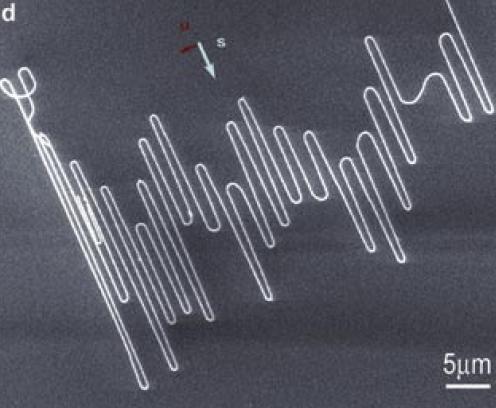Weizmann Institute scientists are developing ways to make nanotubes organize themselves in orderly arrays

Could pieces of paper with words written on them, mixed up in a box, stick together and spontaneously form complete and accurate sentences? The chances of that happening are slim. But in nature, complex structures are indeed formed spontaneously from simple components, in a way known as "self-organization". This phenomenon is known in many fields, including cosmology, geology, plant science and embryonic development.
Dr. Ernesto Yoslevitz, from the Department of Materials and Surface Research at the Weizmann Institute of Science, is trying to reproduce this phenomenon in the world of nanotubes. "Nanotubes made of carbon are molecular wires with unique mechanical, electronic, optical and thermal properties," says Dr. Yuslevitz.
"Their unique properties make them natural candidates to be used as components for building advanced electronic and mechanical devices. But, because of their smallness (thickness is 100,000 times less than the thickness of a human hair), and because of their tendency to gather in clumps, it is difficult for scientists to use them." In order to overcome this difficulty, Dr. Youslevitz and research students Ariel Ishmacht and Noam Gbelingad are trying to develop ways that will make the nanotubes organize themselves in orderly arrays. So far, the scientists have managed to make the nanotubes organize themselves into exotic, snake-like structures and loops, called "curves".
These are the most complex structures created so far from nanotubes. These findings were recently published in the cover article in the scientific journal Nature Nanotechnology. Dr. Yuslevitz says that straight structures of nanotubes may be used to build electronic nanocircuits, but more complex structures, such as the "curves", may be used to build more sophisticated devices.
In order to get the nanotubes to organize themselves into such complex structures, the scientists recruited quite a bit of disorder. Surprisingly, random fluctuations and disorder cause the organization of ordered and complex structures in different areas of nature, so the scientists decided to try and activate disorder in the world of nanotubes as well. In the first step, they used a technique they had developed in a previous study, where they managed to make nanotubes grow on crystals whose surface is not flat, but staggered in steps of atomic size. The nanotubes were "lazy" to climb the stairs, and simply grew in length. In this way, straight structures of parallel nanotubes were formed, although without oscillations and disorder. Therefore, this method cannot lead to the formation of complex structures such as curves.
To "encourage" the nanotubes to organize themselves into complex structures, the scientists injected gas into them during the growth process. But the coupling between the nanotubes to the surface of the crystal was too strong, and the gas was unable to affect the organization of the nanotubes. Here, again, the scientists used the knowledge they obtained in a previous study: certain materials, such as glass, prevent nanotubes from growing on the surface of a crystal, causing them to grow upwards. When the scientists sowed a "seed" of a nanotube in an island of glass placed in an uneven crystal, the growth conditions were created that enabled the formation of complex structures. When the growing nanotube reached a certain length, it quickly collapsed and formed twists, from which the curves were formed.
The scientists discovered that it is possible to control the shape of the resulting curves through changes in their growing conditions. For example, using a strong gas stream causes larger "U-turns", which creates wider curves. Changing the direction of the gas flow causes the formation of spiral coils instead of curves. Each of these structures, and additional structures that will be built in the future, may be suitable for different applications in the fields of nanotechnology.
"The geometry of the curves is widespread in the world of big things, in various systems, such as antennas, radiators, heating and cooling units, as well as in lamps and irrigation systems," says Dr. Yuslevitz. "Nanocurvedons may be used, among other things, to build heat sinks for electronic circuits, electro-optical devices, particularly sensitive infrared detectors, and also to build a dynamo for energy production made from a single molecule. But to me, their most important feature is their beauty."
